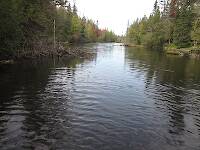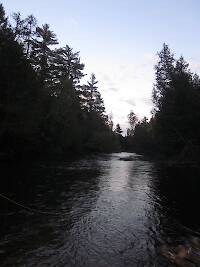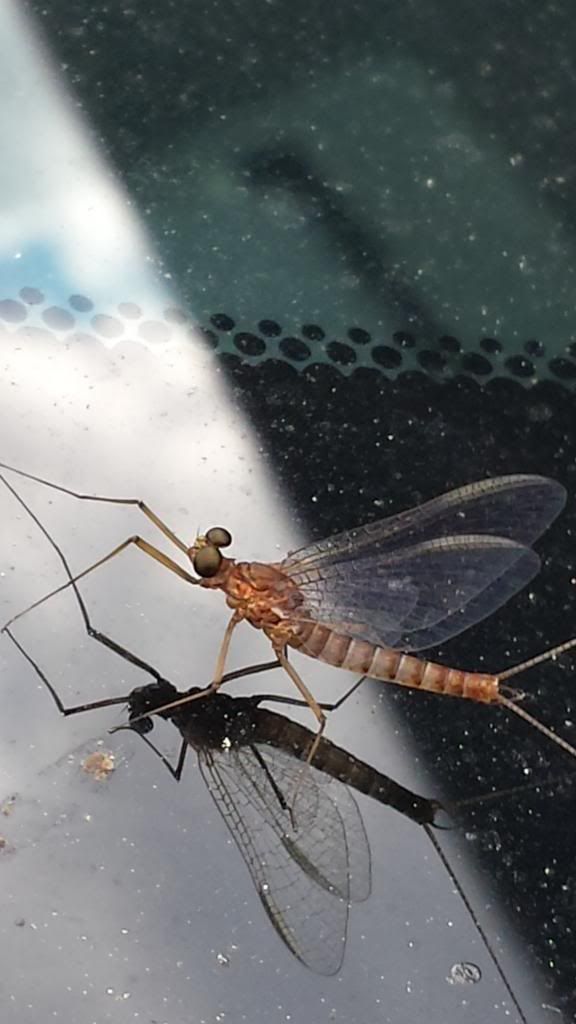
Blue-winged Olives
Baetis
Tiny Baetis mayflies are perhaps the most commonly encountered and imitated by anglers on all American trout streams due to their great abundance, widespread distribution, and trout-friendly emergence habits.
Featured on the forum

With a bit of help from the microscope, this specimen keys clearly and unsurprisingly to Hydropsyche.

Troutnut is a project started in 2003 by salmonid ecologist Jason "Troutnut" Neuswanger to help anglers and
fly tyers unabashedly embrace the entomological side of the sport. Learn more about Troutnut or
support the project for an enhanced experience here.
Taxon on Jan 13, 2014January 13th, 2014, 8:24 pm EST
Hi Byron-
As can be seen: Epeorus pleuralis is limited to NE and SE N. America distribution. I believe this male imago to be Epeorus grandis, which is present in Idaho.
As can be seen: Epeorus pleuralis is limited to NE and SE N. America distribution. I believe this male imago to be Epeorus grandis, which is present in Idaho.
Crepuscular on Jan 14, 2014January 14th, 2014, 4:14 am EST
nice mayfly!
Byhaugh on Jan 14, 2014January 14th, 2014, 10:16 am EST
Couldn't possibly be a heptagenia as in the Pale Evening Dun common name?
Entoman on Jan 14, 2014January 14th, 2014, 12:40 pm EST
Byron -
I wouldn't rule out Heptagenia just yet. For the reasons Taxon stated, this is definitely not a Gordon Quill. We can probably rule out western Epeorus species for other reasons. They (Epeorus) have contiguous eyes (or nearly so), and most importantly lack a transverse mesonotal suture. The costal crossveins usually have some rearward slant to them and are usually paler pigmented. Leg maculation shown in your photo is problematic as well. I have an idea but it would be very helpful if you could provide size and date with your ID requests. Do you (hopefully) remember?
I wouldn't rule out Heptagenia just yet. For the reasons Taxon stated, this is definitely not a Gordon Quill. We can probably rule out western Epeorus species for other reasons. They (Epeorus) have contiguous eyes (or nearly so), and most importantly lack a transverse mesonotal suture. The costal crossveins usually have some rearward slant to them and are usually paler pigmented. Leg maculation shown in your photo is problematic as well. I have an idea but it would be very helpful if you could provide size and date with your ID requests. Do you (hopefully) remember?
"It's not that I find fishing so important, it's just that I find all other endeavors of Man equally unimportant... And not nearly as much fun!" Robert Traver, Anatomy of a Fisherman
Byhaugh on Jan 14, 2014January 14th, 2014, 4:16 pm EST
It was July 6, 2013. It was mid-morning. It was on the Madison, just upstream of the confluence with Westfork. Was a bright sunny day. Insect was a size 13 or 14.
I originally said the Henry's Fork, but checked and it was the Madison.
I originally said the Henry's Fork, but checked and it was the Madison.
Entoman on Jan 15, 2014January 15th, 2014, 1:07 am EST
Very helpful, thanks. Can't quite make out the type of curvature of the mesonotal lateroparapsidal sutures (near the curved brown lines running horizontally along the top of the thorax) so there are several genera that can't be eliminated with meso suture characters alone. However, I think your second idea is probably the right one. Time of year, coupled with size and location make me think of a couple of species of Heptagenia known locally as Ginger Quills or Pale Evening Duns. Unfortunately, color is not necessarily the best way to tell the species apart, as some can be lighter or darker depending on many things. PED works better with paler and more yellowish varieties, so I'll go with Ginger Quill.:) Here's an example of a Heptagenia specimen very similar to yours. http://www.troutnut.com/specimen/1054
I believe I have fished this spinner fall before but it has been many years. From what I remember, it was a cinnamon looking critter with kind of a pearlescent look to the middle terga (abdominal segments). The legs, cloudy grey stigmatic region (upper leading edge) of the fore wings and pale speckled tails look right too. Is that what they looked like in the hand to you? Bugs look different in blown up pictures...:)
PS. Since you weren't boating through quickly, did you notice any of the duns hatching, mixed with those spinners? Was the spinner fall lengthy and/or prolific?
I believe I have fished this spinner fall before but it has been many years. From what I remember, it was a cinnamon looking critter with kind of a pearlescent look to the middle terga (abdominal segments). The legs, cloudy grey stigmatic region (upper leading edge) of the fore wings and pale speckled tails look right too. Is that what they looked like in the hand to you? Bugs look different in blown up pictures...:)
PS. Since you weren't boating through quickly, did you notice any of the duns hatching, mixed with those spinners? Was the spinner fall lengthy and/or prolific?
"It's not that I find fishing so important, it's just that I find all other endeavors of Man equally unimportant... And not nearly as much fun!" Robert Traver, Anatomy of a Fisherman
Byhaugh on Jan 15, 2014January 15th, 2014, 9:38 am EST
Entoman,
Thanks for the analysis.
It was the only insect like it that I noticed that day. Sort of a loner.
There were swarming caddis all over and that is what we were using and catching with.
Thanks again.
I did not know that there were Ginger Quills around there.
If you don't mind, what is the latin name for a ginger quill?
Would it be the S. heteratarsale spinner?
Thanks
Thanks for the analysis.
It was the only insect like it that I noticed that day. Sort of a loner.
There were swarming caddis all over and that is what we were using and catching with.
Thanks again.
I did not know that there were Ginger Quills around there.
If you don't mind, what is the latin name for a ginger quill?
Would it be the S. heteratarsale spinner?
Thanks
Entoman on Jan 15, 2014January 15th, 2014, 11:38 pm EST
You're welcome, Byron.
Yes, we have many mayfly species commonly referred to as Ginger Quills out West. There are also many back East. Your other question has no answer as there is no direct correlation between the Latin and the common. The reason for this is while scientific names are predicated on the identification of a particular species, common names are applied on the basis of appearance and vary by region. Individual common names are applied to multiple species with similar appearance. Conversely, many individual species have multiple common names to cover their various different looking forms.
Also, the eastern inhabiting Stenonema heterotarsale was synonymized with Stenacron interpunctatum quite some time ago and is no longer a valid species name. Interpunctatum now contains many different appearing forms once thought to be separate species. The list of common names in current use for it does include Ginger Quill and Yellow Quill among others but most popular are derivatives of Cahill, i.e. Summer Cahill, Light Cahill, Pale Cahill, Cream Cahill, etc., etc...
Yes, we have many mayfly species commonly referred to as Ginger Quills out West. There are also many back East. Your other question has no answer as there is no direct correlation between the Latin and the common. The reason for this is while scientific names are predicated on the identification of a particular species, common names are applied on the basis of appearance and vary by region. Individual common names are applied to multiple species with similar appearance. Conversely, many individual species have multiple common names to cover their various different looking forms.
Also, the eastern inhabiting Stenonema heterotarsale was synonymized with Stenacron interpunctatum quite some time ago and is no longer a valid species name. Interpunctatum now contains many different appearing forms once thought to be separate species. The list of common names in current use for it does include Ginger Quill and Yellow Quill among others but most popular are derivatives of Cahill, i.e. Summer Cahill, Light Cahill, Pale Cahill, Cream Cahill, etc., etc...
"It's not that I find fishing so important, it's just that I find all other endeavors of Man equally unimportant... And not nearly as much fun!" Robert Traver, Anatomy of a Fisherman
Byhaugh on Jan 16, 2014January 16th, 2014, 8:56 am EST
Someone else said it is Epeorus Albertae????
Entoman on Jan 16, 2014January 16th, 2014, 9:52 am EST
Whoever said that is wrong, Byron.
As I mentioned earlier, Epeorus species have eyes that meet in the middle and smooth mesonotums. It is a little difficult to make out but your specimen has space between its eyes and a transverse mesonotal suture. Albertae (Pink Lady, Yellow Quill, etc.) has additional features that rule it out. Check out this example: http://www.troutnut.com/specimen/926
Besides smaller size and pale cross veins, notice the banded femora and thick black humeral vein? It looks like a small black dot on the lower leading edge of the wings.
As I mentioned earlier, Epeorus species have eyes that meet in the middle and smooth mesonotums. It is a little difficult to make out but your specimen has space between its eyes and a transverse mesonotal suture. Albertae (Pink Lady, Yellow Quill, etc.) has additional features that rule it out. Check out this example: http://www.troutnut.com/specimen/926
Besides smaller size and pale cross veins, notice the banded femora and thick black humeral vein? It looks like a small black dot on the lower leading edge of the wings.
"It's not that I find fishing so important, it's just that I find all other endeavors of Man equally unimportant... And not nearly as much fun!" Robert Traver, Anatomy of a Fisherman
Quick Reply
Related Discussions
Topic
Replies
Last Reply
Re: One should report fishing report even when not much to report... 




In the Photography Board by Oldredbarn
+ 2





In the Photography Board by Oldredbarn
15
Oct 3, 2012
by Entoman
by Entoman
3
Oct 3, 2008
by GONZO
by GONZO





